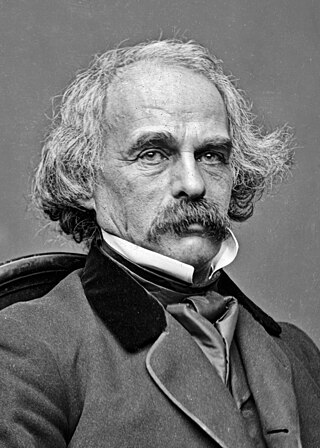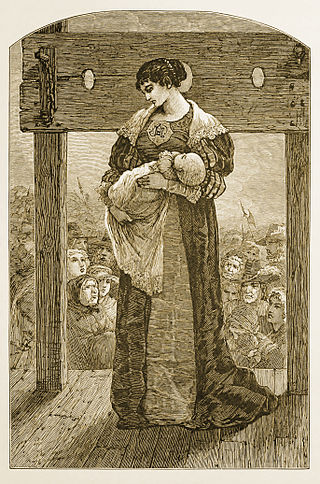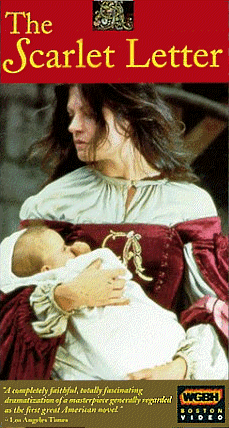
Nathaniel Hawthorne was an American novelist and short story writer. His works often focus on history, morality, and religion.

Tess of the d'Urbervilles: A Pure Woman is a novel by Thomas Hardy. It initially appeared in a censored and serialised version, published by the British illustrated newspaper The Graphic in 1891, then in book form in three volumes in 1891, and as a single volume in 1892. Although now considered a major novel of the 19th century, Tess of the d'Urbervilles received mixed reviews when it first appeared, in part because it challenged the sexual morals of late Victorian England.

The Scarlet Letter: A Romance is a work of historical fiction by American author Nathaniel Hawthorne, published in 1850. Set in the Puritan Massachusetts Bay Colony during the years 1642 to 1649, the novel tells the story of Hester Prynne, who conceives a daughter with a man to whom she is not married and then struggles to create a new life of repentance and dignity. As punishment, she must wear a scarlet letter 'A'. Containing a number of religious and historic allusions, the book explores themes of legalism, sin and guilt.

Not Wanted on the Voyage is a novel by Canadian author Timothy Findley, which presents a magic realist post-modern re-telling of the Great Flood in the biblical Book of Genesis. It was first published by Viking Canada in the autumn of 1984, and was a shortlisted finalist for the Governor General's Award for English-language fiction at the 1984 Governor General's Awards.

Hester Prynne is the protagonist of Nathaniel Hawthorne's 1850 novel The Scarlet Letter. She is portrayed as a woman condemned by her Puritan neighbors for having a child out of wedlock. The character has been called "among the first and most important female protagonists in American literature".

The Scarlet Letter is a 1995 American romantic historical drama film directed by Roland Joffé. Adapted from Nathaniel Hawthorne's 1850 novel of the same name, it stars Demi Moore, Gary Oldman, and Robert Duvall. The film met with overwhelmingly negative reviews. It was nominated for seven Golden Raspberry Awards, winning "Worst Remake or Sequel", and has garnered a legacy as one of the worst films ever made.
Roger Chillingworth is a fictional character and primary antagonist in the 1850 novel The Scarlet Letter by Nathaniel Hawthorne. He is an English scholar who moves to the New World after his wife, Hester Prynne.
Arthur Dimmesdale is a fictional character in the 1850 romance The Scarlet Letter by Nathaniel Hawthorne. A Puritan minister, he has fathered an illegitimate child, Pearl, with Hester Prynne and considers himself unable to reveal his sin.

The Scarlet Letter is a 1979 miniseries based on the 1850 novel of the same name by Nathaniel Hawthorne: it aired on WGBH from March 3, 1979 to March 24, 1979. The series is four episodes long, 60 minutes each. Part 2 won the 1979 Emmy Award for Outstanding Video Tape Editing for a Limited Series or Special for film editors Ken Denisoff, Janet McFadden, and Tucker Wiard.

Ruth is a novel by English author Elizabeth Gaskell, first published in three volumes in 1853.

Roger's Version is a 1986 novel by American writer John Updike.

The Scarlet Letter is a 1926 American silent drama film based on the 1850 novel of the same name by Nathaniel Hawthorne and directed by Swedish filmmaker Victor Sjöström. Prints of the film survive in the MGM/United Artists film archives and the UCLA Film and Television Archive. The film is now considered the best film adaptation of Hawthorne's novel.

Pearl is a primarily feminine given name derived from the English word pearl, a hard, roundish object produced within the soft tissue of a living, shelled mollusk. Pearls are commonly used in jewelry-making. The pearl is the birthstone for the month of June. Pearls have been associated with innocence and modesty. Because it comes from the sea, it also has associations with the moon and with water. Pearls are also traditionally considered appropriate jewelry for debutantes and brides.
Elizabeth Pain, sometimes spelled Elizabeth Paine or Elisabeth Payne, was a settler in colonial Boston who was brought to trial after the death of her child. She was acquitted of the murder charge but found guilty of negligence, fined, and flogged. According to some writers and by popular tradition, aspects of Pain's life and her gravestone are considered an inspiration for the life and grave of character Hester Prynne in the novel The Scarlet Letter by Nathaniel Hawthorne.
In The Blood is a play written by Suzan-Lori Parks which premiered at The Joseph Papp Public Theater in 1999. Parks borrowed many aspects from Nathaniel Hawthorne's 1850 novel The Scarlet Letter, and wanted to create a play based on the novel. She originally wanted to call the play Fucking A, but scrapped the idea. She later wrote the story based on the main character from The Scarlet Letter, and turned the story into more modern era, and changed the title to In The Blood. She later wrote a different play that she did title Fucking A.
Fucking A is a play written by American playwright Suzan-Lori Parks. It was produced by DiverseWorks and Infernal Bridegroom Productions and premiered in Houston, Texas on February 24, 2000.

The Scarlet Letter is a 1934 American film directed by Robert G. Vignola and based on the 1850 novel of the same name by Nathaniel Hawthorne.

Ann Hibbins was a woman executed for witchcraft in Boston, Massachusetts Bay Colony, on June 19, 1656. Her death by hanging was the third for witchcraft in Boston and predated the Salem witch trials of 1692. Hibbins was later fictionalized in Nathaniel Hawthorne's famous novel The Scarlet Letter. A wealthy widow, Hibbins was the sister-in-law by marriage to Massachusetts governor Richard Bellingham. Her sentence was handed down by Governor John Endicott.

Buttons: A Christmas Tale is a 2018 American fantasy drama film directed by Tim Janis, and starring Ioan Gruffudd, Jane Seymour, Roma Downey, Abigail Spencer, Dick Van Dyke and Angela Lansbury, with narration by Robert Redford and Kate Winslet.
The Scarlet Letter is an American silent drama film distributed by Fox Film Corporation and based upon the 1850 eponymous novel by Nathaniel Hawthorne, with some additional plot added taking place before the events of the novel. It was written and directed by Carl Harbaugh. An incomplete print of the film in 1 reel exists. The film used the novel's text to create subtitles, and in 1917 The Moving Picture World called it "as nearly flawless as it is humanly possible for it to be."













